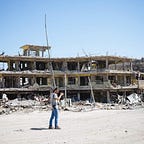Armenia The war of existence
Starting by defining the ”mercenary” which is every person who serves in the armed forces of a foreign country for money
Note that mercenary wars have become a global fashion the countries of the world are heading to in light of ( the failed revolutions) and civil wars in the region.
According to reports, dozens of people have died amid ongoing clashes between forces of the two countries in Nagorno Karabakh, a mountainous region inhabited by ethnic Armenians and surrounded by Azerbaijani lands. The bloody war led by mercenaries against the Armenian race
Turkey
From the first moments of the conflict, Turkey’s position was clear, which is the support and support of Azerbaijan, and after the recent developments, the Turkish President announced his country’s full support for Azerbaijan, and press reports stated that he sent Syrian mercenaries to Azerbaijan to help it in its war.
Personally, I am not surprised that Turkey takes the terrorists out of its prisons and send them to Armenian territory to kill the Arminians there.
Iran
As for the Iranian position on the conflict, it was “strange” as it gave up support for Azerbaijan and stood by Armenia, despite the existence of cultural, ethnic, and religious ties between Tehran and Baku, where nearly a third of Iranians belong to the Azeri ethnicity, and the majority of the Azerbaijani people owe the Shiite sect. And they follow religious references in the Iranian Qom and Tabriz.
Russia
Azerbaijan and Armenia were part of the Soviet Union, until its collapse in the early 1990s, and Baku’s declaration of independence in 1991.
Despite Moscow’s calls for the two countries to a ceasefire, it supports and supports Armenia, as Armenia is an important strategic and economic of Moscow. Russia has a military base in Armenia and about 40% of foreign investments in it.
America
As for the American position, it is neutral and seeks to resolve the conflict between the two countries. After the recent developments, Washington went out and declared its condemnation of the escalation of violence between Azerbaijan and Armenia, and called on both sides to immediately stop hostilities, offering condolences to the families of the civilian victims.
The US State Department said in a statement, on Sunday, that the two sides must end the violence “immediately”, as well as end any speech or other measures that could increase tension.
The Foreign Ministry added: “Any participation in violence from outside parties will be completely useless and will only serve to raise regional tensions. We call on the parties to work within the Minsk Group to return to serious talks as soon as possible.”
This position is the same as the position of European countries seeking to end this historic conflict on their borders.
Israel
Israel takes the side of the Azerbaijani position in the conflict. Israel is one of Baku’s strongest allies since 2011, and media reports revealed that Israel sold millions of dollars of weapons to Azerbaijan.
Analysts also see Azerbaijan as a new point of conflict and competition between Iran and Israel, as Israel is seeking to gain a foothold near the Iranian border.
What do you know about the “Armenian massacres” committed by the Ottomans?
Armenians say that the Ottoman Empire exterminated 1.5 million Armenians during that period between 1915–1917.
And it recognized 30 “Armenian genocide”, including France, Germany, Belgium, Lithuania, Bulgaria, the Netherlands, Switzerland, Greece, Argentina, Uruguay, Russia, Slovakia, and Austria.
The dispute is not new at all, and its roots go back to 1921 when the Soviet authorities annexed this region to Azerbaijan, but in 1991, unilateral independence was declared with the support of Armenia, which caused a war that killed 30,000 people, and it stopped after the ceasefire agreement in 1994.
The Nagorno Karabakh region inhabits the majority of Armenians, and it is 170 miles from the Azerbaijani capital, and very close to the border with Armenia, and although it is not recognized, some classify it as a landlocked country in Eastern Europe.
In 2016, bloody clashes in Nagorny Karabakh almost sparked a war between the two sides, in which 100 people were killed on both sides.
Armenia, which controls the disputed region, is satisfied with the status quo. As for Azerbaijan, which is rich in energy resources and whose military spending exceeds Armenia’s entire budget, it threatens to regain control of the region by force.
Last July, the two neighbors accused each other of launching an attack on the common border, which caused two deaths and wounded 5 Azeri forces.
This latest escalation came after statements by Azerbaijani President Ilham Aliyev last week, in which he threatened to withdraw from the peace talks on Karabakh, and considered that his country has the right to seek “a military solution to the conflict.”
But what ignites the conflict in the Caucasus region is that it is more than just a dispute between two countries over a border region, but rather a struggle between a group of states over control of this important region, which is considered a gateway to Europe.
How can this conflict end?
If we look at the long history of conflict between the two countries, this conflict cannot be resolved by two leaders in one room; Because it is a conflict rooted in the depth of the general national consciousness; What requires, first, to get rid of distrust, mistrust, and the legacy of historical hostility between Armenians and Azerbaijanis.
However, there is a scenario, if activated, that will contribute to resolving the conflict between Armenia and Azerbaijan, which is the Minsk plan; According to this scenario, the three parties must: Armenia, Azerbaijan and Karabag agree on the necessity of recognition of the territorial integrity of Azerbaijan coupled with the autonomy of Karabakh by local Armenians.
And solve the case
write to Majd.helobi@gmail.com
